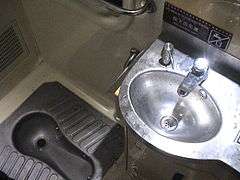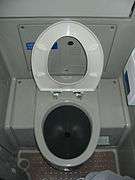Passenger train toilet
Many passenger trains (usually medium and long-distance) have toilet facilities, often at the ends of carriages. Toilets suitable for wheelchair users are larger, and hence trains with such facilities may not have toilets in each carriage.
Hopper toilet
The traditional method of disposing human waste from trains is to deposit the waste onto the tracks using what is known as a hopper toilet. This ranges from a hole in the floor to a full-flush system (possibly with sterilization). The hole in the floor (also known as a drop chute toilet) system is still in use in many parts of the world, particularly on older rolling stock. The principal disadvantage is that it can be considered crude or unhygienic and dangerous to health and the environment – it litters the railway lines and can convey serious health risks when the train passes over or under a navigable waterway. Passengers may be discouraged from flushing or using toilets while the train is at a station or standing at a red signal. To enforce this limitation, toilets may be automatically locked when the train pulls into a station or stops at a red signal.
Properly-designed drop chute toilets will draw air like a chimney, pulling air through the lavatory door vents and down and out through the toilet, reducing odor.[1]
Hopper toilets are similar to old-fashioned sea toilets in that they release the excreta directly to the environment, untreated.
Chemical holding tank
Chemical holding tanks (retention tanks) are usually included on newer carriages and railcars in wealthier and more densely populated parts of the world. One issue is that the tanks need to be regularly emptied, often at a terminal station or prolonged stop-over. If a train needs to be used again quickly, the tanks may not get emptied. In this case, toilets may back up, which can result in toilets being closed.
Composting toilet
Some trains may have composting toilet tanks, which use bacterial action to break down solid and liquid waste before releasing it to the trackbed by way of a chlorine sanitizing tank.
Cultural references
In the United States, Dvořák's tune "Humoresque Number 7" became the setting for a series of mildly scatological humorous verses,[2] regarding passenger train toilets, beginning:
Passengers will please refrain
From flushing toilets while the train
Is standing in the station (I love you)...
Gallery
 Traditional hole in the floor system, operated by a pedal
Traditional hole in the floor system, operated by a pedal
 Squat toilet in Chinese train
Squat toilet in Chinese train Toilet in Taiwan high speed rail train
Toilet in Taiwan high speed rail train "DO NOT USE the toilet while the train is stopped at the station" notice in Polish, German, French, and English, displayed by Polish State Railways
"DO NOT USE the toilet while the train is stopped at the station" notice in Polish, German, French, and English, displayed by Polish State Railways.jpg) Vacuum waste tank on a China Railways 25T coach
Vacuum waste tank on a China Railways 25T coach
References
- ↑ http://toilet-guru.com/train.php Toilets of the World: Train Toilets
- ↑ Horntip, Retrieved 2012-08-31.